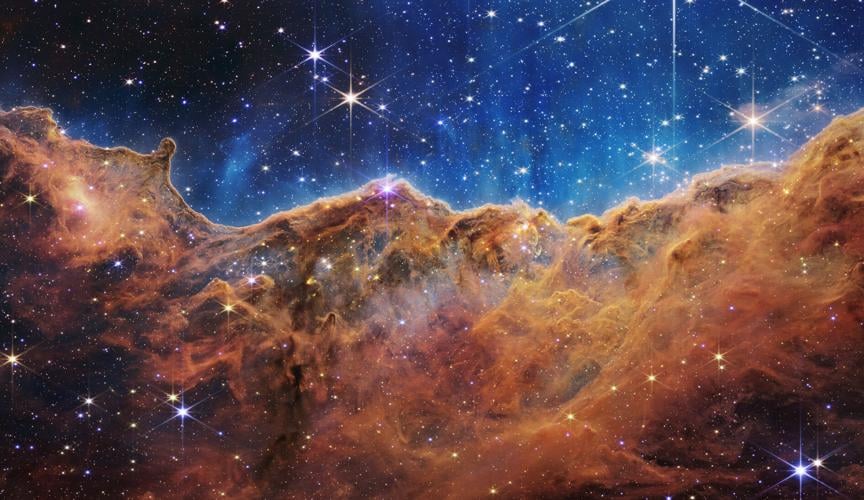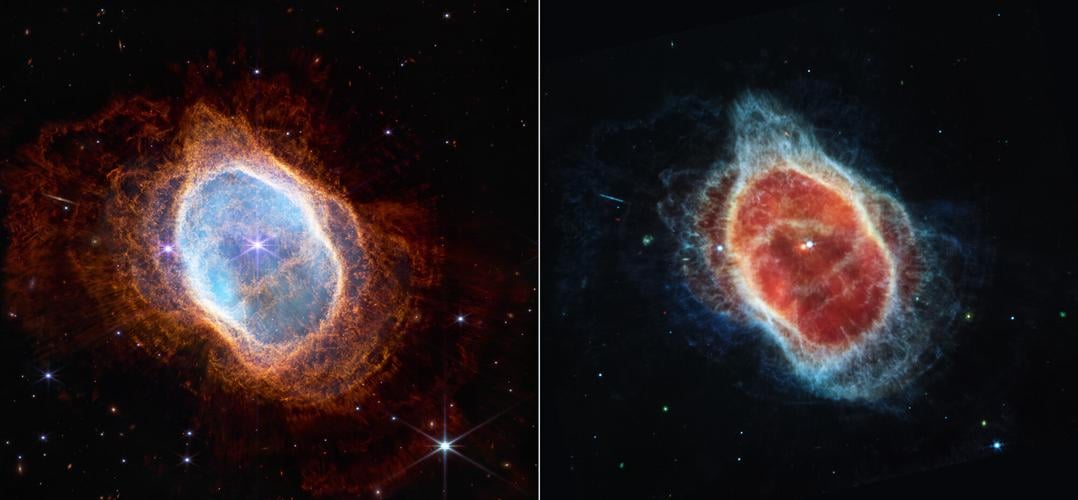Thousands of galaxies swirl in a patch of sky no bigger than a grain of sand held at arm’s length.
Water molecules streak through the atmosphere of a giant exoplanet quadrillions of miles from Earth.
The rusty peaks and canyons of Cosmic Cliffs cradle newborn stars like the Catalinas on a moonlit night.
NASA’s James Webb Space Telescope delivered a taste of many wonders to come, with the release Tuesday of the first full-color scientific images and spectrographic data captured by the $10 billion infrared observatory with strong ties to Tucson.
University of Arizona research professor Stacey Alberts has been working on Webb for the past eight years, and even she was surprised by the depth and beauty captured in the first images.
“It’s day 1, and we’re already seeing features like never before. They’re just popping,” the astronomer said. “We’re going to revolutionize the field, and it’s going to take a week instead of a year.”
Alberts serves on the instrument teams for two of Webb’s key components: the Near Infrared Camera, or NIRCam, and the Mid-Infrared Instrument, or MIRI.
Several dozen UA astronomers, engineers and students played roles in the development of the two instruments, none more so than the university’s resident infrared astronomy power couple.
Regents’ professor Marcia Rieke led the development team and now serves as principal investigator for NIRCam, which serves as the telescope’s main camera with light sensors designed, built and tested at the UA.
Her husband, fellow Regents’ professor George Rieke, is science team lead for MIRI, a camera and spectrograph he helped design.
The Riekes were among a select group of Webb insiders who got a sneak peak of the telescope’s first images Friday, a few days before they were unveiled to the rest of the world.
Marcia Rieke expected them to be good, but she was not prepared for what she saw.
“Spectacular, mind-blowing, more amazing than I could have hoped,” she said. “You realize, ‘I didn’t waste 20 years of my life.’ It was worth it.”
Background objects that showed up as blurs — or not all — in images from the Hubble or Spitzer space telescopes could now be seen for what they are: bright, distinct spirals packed with billions of stars.
“Webb is so good at detecting galaxies that galaxies are photo-bombing us all over the place,” she said.
George Rieke summed up his reaction with a single word: “Wow!”
He said Webb’s first deep view into the dust and gas of the Southern Ring Nebula, for example, has already rendered similar images captured by the Hubble “completely boring.”
He is more convinced than ever that the new telescope will lead to advances in almost every area of astronomy. Researchers are “almost assured” to discover things no one has ever seen before, he said. “We’re going to make people have to rewrite the textbooks.”
Long journey
Webb was launched on Christmas Day 2021, after years of delays and cost overruns.
It took the spacecraft about a month to reach its final destination roughly 1 million miles from Earth, where it entered a parallel orbit around the sun.
Along the way, Webb executed a series of complicated maneuvers to deploy its heat shield and unfold the 18 segments that work together to form the largest telescope mirror ever flown in space.
That mirror and the instruments tied to it then underwent months of adjustment and commissioning.
Tuesday’s image release marks the official start of the telescope’s long-awaited science mission.
“There’s data that’s going to be coming tomorrow,” Alberts said. “It’s crazy.”
Webb’s first five scientific targets were chosen by an international committee from NASA, the European Space Agency, Canadian Space Agency and the Space Telescope Science Institute, which are all partners on the project.
The selections were meant to highlight Webb’s wide range of applications, from studying the most distant observable galaxies in the early universe to analyzing the atmospheres of neighboring exoplanets in search of potentially habitable worlds.
The four new images released Tuesday include:
• The Carina Nebula, home to the Cosmic Cliffs, where Webb has already revealed previously invisible areas where new stars are forming;
• Southern Ring Nebula, where waves of dust and gas expelled by a dying star over thousands of years offer scientists new clues about stellar death and rebirth;
• Stephan’s Quintet, a much-studied compact group of galaxies shown in unprecedented detail in a mosaic of almost 1,000 Webb images, revealing newly formed stars, shock waves and sweeping tails of gas being stripped away by collisions on a galactic scale;
• And exoplanet WASP-96b, 1,150 light-years away in the southern-sky constellation Phoenix, where Webb quickly detected water molecules in an atmosphere roiled by the puffy gas giant’s close proximity to its sun-like star.
The four images were released online one at a time Tuesday morning, causing a stir among astronomy enthusiasts around the world. Google marked the occasion with an animated search-engine doodle dedicated to Webb.
Even President Joe Biden and Vice President Kamala Harris got in on the act, unveiling the first image during a Monday afternoon news conference at the White House: a deep view of a galaxy cluster known as SMACS 0723 that represents the deepest and sharpest infrared look at the distant universe ever made — at least so far.
Tucson ties
The unprecedented image was assembled using data collected by Webb during 12½ hours of observing time, and it’s only a small taste of what the telescope can do.
Starting in September, Webb will spend around 800 hours peering far deeper into the universe than ever before as part of an effort to refine and expand upon Hubble’s famous Ultra Deep-Field image. That composite of hundreds of observations from one small region of space contains roughly 10,000 galaxies, including some dating back more than 13 billion years to when the universe was only a few hundred million years old.
The James Webb Space Telescope Advanced Deep Extragalactic Survey will examine the same dark patch of sky, using combined data from NIRCam and MIRI to peer through dust clouds and capture some of the earliest stars and galaxies to form after the Big Bang.
Such deep views through cosmic dust will also help astronomers find other hidden objects lurking in space, Alberts said.
“We might be missing up to half of the black holes in the universe, and this is how we’re going to find them,” she said.
Alberts specializes in the study of galaxies and what happens to them when they get too close to their neighbors. She can’t wait for her turn with Webb.
In April, she is scheduled to point the telescope at the Norma constellation, more than 200 million light-years away, where a galaxy known as ESO 137-001 is being stripped of its star-forming gas as it plunges through one of the largest known galaxy clusters.
The chance to work on Webb is what lured Alberts to the UA for her post-doctoral work in 2014.
“That was pretty much it,” she said.
Her decision is about to pay off in a major way. NASA has allotted 13% of Webb’s total observing time to the university, the most of any astronomy center in the world.
That’s no accident as far as George Rieke is concerned. It’s the return on an investment the university made in the 1960s, when it recruited such astronomy pioneers as Gerard Kuiper and Frank Low.
“Modern infrared astronomy started at the U of A,” George Rieke said, so it’s only fitting that the next round of new discoveries in the field might just be made right here.







